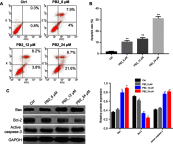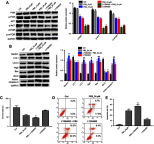Grape seed procyanidin B2 promotes the autophagy and apoptosis in colorectal cancer cells via regulating PI3K/Akt signaling pathway
- PMID: 31213831
- PMCID: PMC6538883
- DOI: 10.2147/OTT.S195615
Grape seed procyanidin B2 promotes the autophagy and apoptosis in colorectal cancer cells via regulating PI3K/Akt signaling pathway
Erratum in
-
Grape seed procyanidin B2 promotes the autophagy and apoptosis in colorectal cancer cells via regulating PI3K/Akt signaling pathway [Corrigendum].Onco Targets Ther. 2019 Jun 14;12:4665. doi: 10.2147/OTT.S217890. eCollection 2019. Onco Targets Ther. 2019. PMID: 31354299 Free PMC article. No abstract available.
Abstract
Aim: Colorectal cancer (CRC) is a major malignancy in China, which is the critical risk of people health. Many natural herbs extracts have been found to exhibit good therapeutic effect on CRC. Our previous study found that grape seed procyanidins B2 (PB2) would induce CRC cell death. However, the molecular mechanism underlying its anti-tumor effect on CRC remains unclear. Thereby, this study aimed to investigate the anti-tumor mechanism of PB2 on CRC. Methods: CCK-8, western blotting, flow cytometry, qRT-PCR and animal study were used in the current study. Results: The in vitro and in vivo data demonstrated that PB2 could promote the apoptosis of CRC cells in a dose-dependent manner, which was significantly reversed by caspase 3 inhibitor. Meanwhile, PB2 dose-dependently induced autophagy in CRC cells, which was markedly attenuated by autophagy inhibitor 3-MA. In addition, PB2 dose-dependently inhibited the expressions of p-PI3K, p-Akt and p-mTOR in the cells. Conclusion: PB2 dose-dependently induced apoptosis and autophagy in CRC cells via downregulation of PI3K/Akt pathway. This study provided the experimental basis for further development of PB2 as a new effective anticancer drug for the patients with CRC.
Keywords: PI3K/Akt/mTOR signaling pathway; apoptosis; autophagy; colorectal cancer; grape seed procyanidin extract.
Conflict of interest statement
The authors report no conflicts of interest in this work.
Figures






Similar articles
-
Naringin inhibits colorectal cancer cell growth by repressing the PI3K/AKT/mTOR signaling pathway.Exp Ther Med. 2020 Jun;19(6):3798-3804. doi: 10.3892/etm.2020.8649. Epub 2020 Apr 7. Exp Ther Med. 2020. PMID: 32346444 Free PMC article.
-
α-Mangostin inhibits DMBA/TPA-induced skin cancer through inhibiting inflammation and promoting autophagy and apoptosis by regulating PI3K/Akt/mTOR signaling pathway in mice.Biomed Pharmacother. 2017 Aug;92:672-680. doi: 10.1016/j.biopha.2017.05.129. Epub 2017 Jun 3. Biomed Pharmacother. 2017. PMID: 28582759
-
Grape seed procyanidin B2 promotes the autophagy and apoptosis in colorectal cancer cells via regulating PI3K/Akt signaling pathway [Corrigendum].Onco Targets Ther. 2019 Jun 14;12:4665. doi: 10.2147/OTT.S217890. eCollection 2019. Onco Targets Ther. 2019. PMID: 31354299 Free PMC article. No abstract available.
-
Natural Compounds Targeting the Autophagy Pathway in the Treatment of Colorectal Cancer.Int J Mol Sci. 2023 Apr 15;24(8):7310. doi: 10.3390/ijms24087310. Int J Mol Sci. 2023. PMID: 37108476 Free PMC article. Review.
-
Deconvoluting the complexity of autophagy in colorectal cancer: From crucial pathways to targeted therapies.Front Oncol. 2022 Sep 12;12:1007509. doi: 10.3389/fonc.2022.1007509. eCollection 2022. Front Oncol. 2022. PMID: 36172152 Free PMC article. Review.
Cited by
-
Ethnobotany, phytochemistry and pharmacological properties of Fagopyri Dibotryis Rhizoma: A review.Front Pharmacol. 2023 Mar 6;14:1095554. doi: 10.3389/fphar.2023.1095554. eCollection 2023. Front Pharmacol. 2023. PMID: 36950009 Free PMC article. Review.
-
Procyanidin A1 alleviates DSS-induced ulcerative colitis via regulating AMPK/mTOR/p70S6K-mediated autophagy.J Physiol Biochem. 2022 Feb;78(1):213-227. doi: 10.1007/s13105-021-00854-5. Epub 2022 Jan 10. J Physiol Biochem. 2022. PMID: 35001346
-
Procyanidin B2 induces apoptosis and autophagy in gastric cancer cells by inhibiting Akt/mTOR signaling pathway.BMC Complement Med Ther. 2021 Feb 24;21(1):76. doi: 10.1186/s12906-021-03225-1. BMC Complement Med Ther. 2021. PMID: 33627124 Free PMC article.
-
RNA-seq and metabolomic analyses of beneficial plant phenol biochemical pathways in red alder.Front Plant Sci. 2024 Nov 7;15:1349635. doi: 10.3389/fpls.2024.1349635. eCollection 2024. Front Plant Sci. 2024. PMID: 39574452 Free PMC article.
-
Selected Seeds as Sources of Bioactive Compounds with Diverse Biological Activities.Nutrients. 2022 Dec 30;15(1):187. doi: 10.3390/nu15010187. Nutrients. 2022. PMID: 36615843 Free PMC article. Review.
References
LinkOut - more resources
Full Text Sources
Research Materials
Miscellaneous

